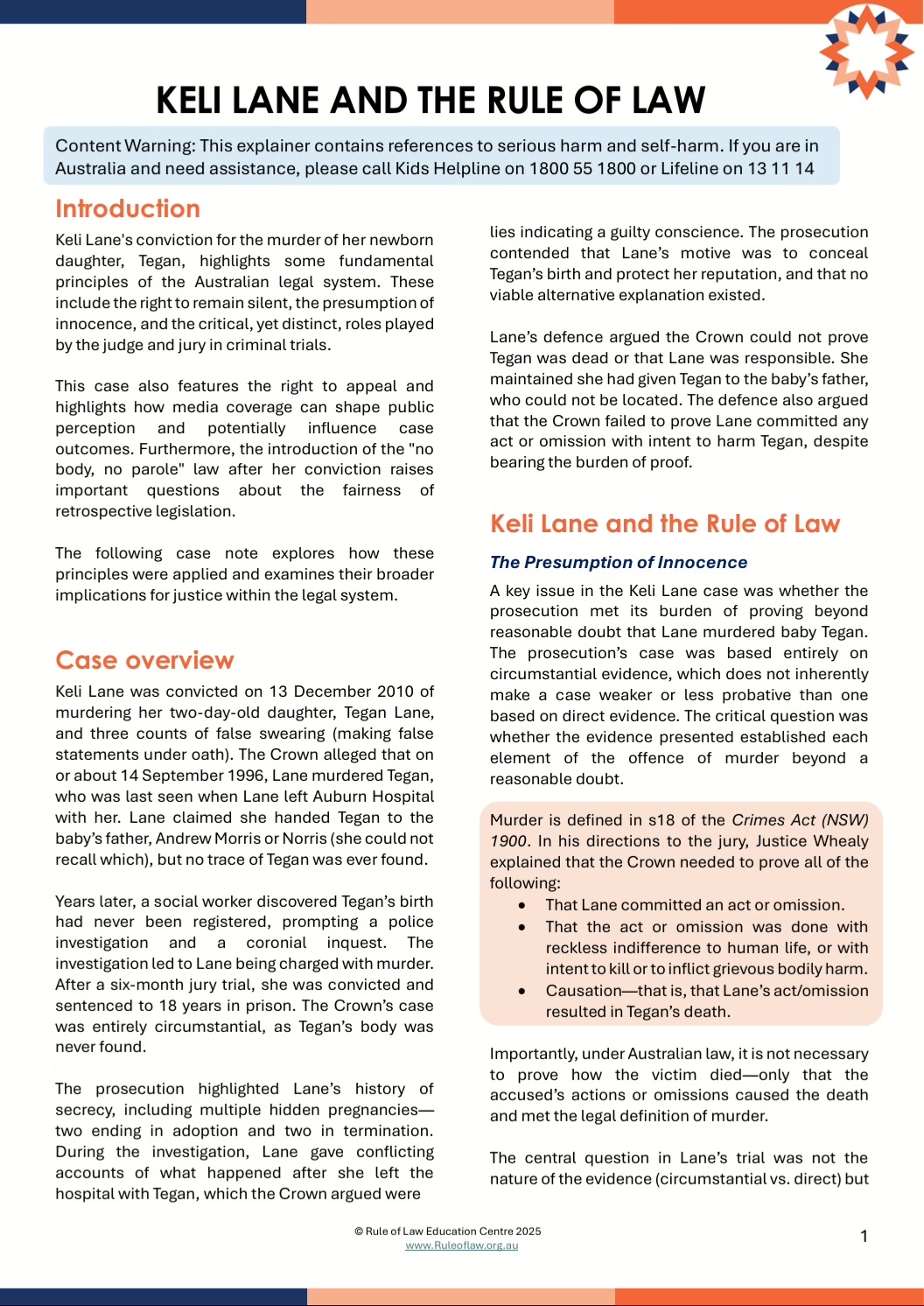Keli Lane Case Note
The Keli Lane case has captured the attention of the Australian public for over a decade since questions first emerged regarding the disappearance of Keli Lane’s baby Tegan in 2005. This attention intensified when Lane was charged with Tegan’s murder and subsequently found guilty by a Jury in 2010.
Introduction
Keli Lane’s conviction for the murder of her newborn daughter, Tegan, highlights some fundamental principles of the Australian legal system. These include the right to remain silent, the presumption of innocence, and the critical, yet distinct, roles played by the judge and jury in criminal trials.
This case also features the right to appeal and highlights how media coverage can shape public perception and potentially influence case outcomes. Furthermore, the introduction of the “no body, no parole” law after her conviction raises important questions about the fairness of retrospective legislation.
The following case note explores how these principles were applied and examines their broader implications for justice within the legal system.
Case overview
Keli Lane was convicted on 13 December 2010 of murdering her two-day-old daughter, Tegan Lane, and three counts of false swearing (making false statements under oath). The Crown alleged that on or about 14 September 1996, Lane murdered Tegan, who was last seen when Lane left Auburn Hospital with her. Lane claimed she handed Tegan to the baby’s father, Andrew Morris or Norris (she could not recall which), but no trace of Tegan was ever found.
Years later, a social worker discovered Tegan’s birth had never been registered, prompting a police investigation and a coronial inquest. The investigation led to Lane being charged with murder. After a six-month jury trial, she was convicted and sentenced to 18 years in prison. The Crown’s case was entirely circumstantial, as Tegan’s body was never found.
The prosecution highlighted Lane’s history of secrecy, including multiple hidden pregnancies—two ending in adoption and two in termination. During the investigation, Lane gave conflicting accounts of what happened after she left the hospital with Tegan, which the Crown argued were
lies indicating a guilty conscience. The prosecution contended that Lane’s motive was to conceal Tegan’s birth and protect her reputation, and that no viable alternative explanation existed.
Lane’s defence argued the Crown could not prove Tegan was dead or that Lane was responsible. She maintained she had given Tegan to the baby’s father, who could not be located. The defence also argued that the Crown failed to prove Lane committed any act or omission with intent to harm Tegan, despite bearing the burden of proof.
Keli Lane and the Rule of Law
The Presumption of Innocence
A key issue in the Keli Lane case was whether the prosecution met its burden of proving beyond reasonable doubt that Lane murdered baby Tegan. The prosecution’s case was based entirely on circumstantial evidence, which does not inherently make a case weaker or less probative than one based on direct evidence. The critical question was whether the evidence presented established each element of the offence of murder beyond a reasonable doubt.
Murder is defined in s18 of the Crimes Act (NSW) 1900. In his directions to the jury, Justice Whealy explained that the Crown needed to prove all of the following:
-
- That Lane committed an act or omission.
- That the act or omission was done with reckless indifference to human life, or with intent to kill or to inflict grievous bodily harm.
- Causation—that is, that Lane’s act/omission resulted in Tegan’s death.
Importantly, under Australian law, it is not necessary to prove how the victim died—only that the accused’s actions or omissions caused the death and met the legal definition of murder.
The central question in Lane’s trial was not the nature of the evidence (circumstantial vs. direct) but whether the prosecution proved each element of the offence beyond reasonable doubt.
The Right to Silence
During the trial, Keli Lane exercised her right to remain silent, a fundamental legal principle linked to the presumption of innocence. This right ensures that no accused person is required to incriminate themselves, and there is no obligation for them to give evidence. Instead, the prosecution must prove, beyond a reasonable doubt, that the accused committed each element of the offence.
The underlying rationale for this right (and the presumption of innocence) lies in the imbalance of resources between the State/Crown, represented by the prosecution, and the defendant. The State has extensive resources at its disposal, including law enforcement and a team of highly educated legal professionals, while the defendant typically has far fewer means to defend themselves.
At the time of Lane’s trial, an accused person had the right to remain silent from the moment of arrest through to the end of their trial.
Section 89 of the Evidence Act 1995 (NSW) provides that if an accused chooses not to testify, answer questions, or respond to statements, no adverse inference can be drawn from their silence.
It is important to note that the law has since changed. In 2013, after Lane’s trial, the NSW Government introduced Section 89A, which applies to serious indictable offences. This amendment allows a court to draw an unfavourable inference if an accused remains silent about a fact they later rely on as part of their defence – particularly if they could reasonably have been expected to mention it earlier.
This means that if an accused person fails to disclose an alibi or other key information when first questioned by police but later presents it in court as part of their defence, the judge/jury is allowed to view this silence as suspicious.
The role of Judge and Jury in a Criminal Trial
Understanding the distinct roles of the judge and jury in a criminal trial is essential:
The Jury’s role
The jury serves as the factfinder in a trial – they are the ‘adjudicator of fact’. Their responsibilities include:
-
- Assessing the evidence presented in court;
- Determining the credibility of witnesses and other forms of evidence;
- Deciding whether the prosecution has proven each element of the charge beyond a reasonable doubt; and
- Delivering a verdict based on their findings.
The Judge’s role
The judge, on the other hand, ensures that the trial adheres to legal principles and procedural fairness – they are the ‘adjudicator of law’. The High Court case of Alford v Magee [1952] established the key duties of a judge in a jury trial, which include:
-
- Explaining the relevant law to the jury in a clear and focused manner;
- Framing that legal explanation within the specific facts of the case;
- Clarifying how the law applies to those facts;
- Providing guidance on issues contested by the parties; and
- Identifying the key legal and factual disputes in the case.
Judicial Commentary and the Jury’s Verdict
Following Lane’s conviction, attention was given to comments made by Judge Whealy expressing discomfort with the jury’s verdict. He reportedly felt that the prosecution had not proven its case beyond a reasonable doubt. Critics of the trial often cite these remarks as evidence that the jury reached the wrong conclusion.
However, it is crucial to recognise that, within a jury trial, a judge’s personal views of the verdict have no legal bearing. While they may comment on a verdict post-trial, it is generally considered inappropriate for a judge to publicly express disagreement with a jury’s decision. The jury’s findings of fact are final, and the judge’s role is limited to explaining the law, overseeing the trial’s fairness, and imposing a sentence where necessary.
Right to Appeal
A fundamental principle of Australia’s legal system is the right to appeal, which allows individuals to challenge a court’s decision in a higher court. Appeals can only be made on specific grounds, including:
-
- An error of law;
- An error of fact; or
- An error of mixed fact and law
In the case of Lane, her appeal was heard by the New South Wales Court of Criminal Appeal, the highest criminal court in the State, with only the High Court of Australia above it. This court usually comprises three judges, though five may preside when significant legal issues arise. Judges may deliver individual decisions – in which case the verdict will be by majority, or they may issue a joint judgment.
Lane appealed her conviction for murder on eight grounds, including claims that the trial judge failed to consider alternative charges, i.e., manslaughter, that prejudicial remarks were made by the Crown Prosecutor, and that certain legal directions were not given to the jury. However, after hearing the case, the Court of Appeal upheld the jury’s original verdict.
The judicial appeal system plays a crucial role in maintaining accountability and fairness in the legal system. It ensures that court decisions adhere to the law and provides a safeguard against judicial errors.
Media influence
The media can have a huge impact on criminal cases. It can shape public opinion and can interfere with the principles of natural justice, making it harder for a person to get a fair trial.
The idea of being ‘innocent until proven guilty’ is the cornerstone of all natural justice principles. But when the media covers a case in a dramatic or biased way, it can make people believe someone is guilty before the trial even starts.
In the case of Keli Lane, the media focused a lot on her multiple secret pregnancies, and her relentless drive to achieve success as an athlete. This painted her as a ruthless and untrustworthy defendant before the verdict was handed down.
Judges try to uphold fairness by telling juries to ignore media coverage, but this isn’t always effective. In big cases, jurors are often exposed to news reports and social media discussions long before they step into the classroom, making it difficult to remain completely impartial.
Click here to read our resource on juries.
This raises an important question: how do we balance freedom of the press with the right to a fair trial?
Retrospective laws
The “No Body, No Parole” laws were introduced in NSW in 2022 to prevent convicted murderers from being granted parole unless they disclose the location of their victim’s remains. These laws seek to uphold accountability and provide closure for victims’ families. Supporters argue that these laws prevent convicted criminals from manipulating the system, while critics raise concerns about fairness, particularly for those who maintain their innocence.
A key principle of the rule of law is that laws should not be applied retrospectively. This means that offenders convicted before these laws were introduced, such as Keli Lane, should not be forced to comply with them.
Keeping someone in prison longer just because of a law, despite no clear evidence of a crime, raises serious questions about justice. The “No body, No parole” rule was meant to bring closure to victims’ families, but in Keli Lane’s case, Tegan’s own family believes she is innocent. Some argue that extending her sentence seems more like a punishment for not confessing rather than a fair application of the law.
Retrospective laws undermine legal certainty by changing the consequences of past actions. While the “No Body, No Parole” laws serve an important role in securing justice for victims and their families, they must also be balanced with fundamental legal principles to ensure fairness and consistency in the application of the law.
For more information on retrospective laws, click here.
Conclusion
Keli Lane’s case underscores core principles of the rule of law, including the balance between the right to silence and explaining suspicious circumstances, the presumption of innocence in the absence of physical evidence, and the distinct responsibilities of judge and jury in complex cases. It also reveals the influence of media on public opinion and the complications of retrospective laws. Ultimately, this case raises important questions about fairness, justice, and how the legal system balances competing priorities.

